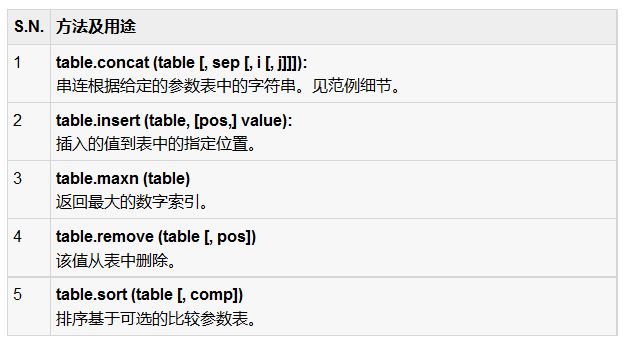萬盛學電腦網 >> 網絡編程 >> 編程語言綜合 >> 詳解Lua中的表的概念及其相關操作方法
詳解Lua中的表的概念及其相關操作方法
這篇文章主要介紹了Lua中的表的概念及其相關操作方法,是Lua入門學習中的基礎知識,需要的朋友可以參考下
表格是唯一的數據結構中Lua可以幫助我們創造出不同的類型,如數組和字典。 Lua使用關聯數組和可不僅數字,但也有不同的零字符串索引。表格都沒有固定的大小,並根據需要可以增長。
Lua采用的所有陳述,包括包裝的代表性表。當我們訪問一個方法的字符串。格式,這意味著,我們正在訪問的格式化功能的字符串封裝。
表示和用法
表稱為對象和它們既不值,也沒有變。 Lua使用構造函數表達式{}創建一個空表。它是要知道,有保存表的參考和表本身的變量之間沒有固定的關系。
代碼如下:
--sample table initialization
mytable = {}
--simple table value assignment
mytable[1]= "Lua"
--removing reference
mytable = nil
-- lua garbage collection will take care of releasing memory
當我們有一個表與集合的元素,如果我們將其指定為b,a和b都指向相同的內存。沒有單獨的內存單獨分配對b。當設置為無,表將仍然可以訪問到b。當沒有引用表,然後在Lua垃圾收集需要清理過程,使這些未引用的內存再次被重用。
一個例子如下所示用於說明表的上述特征。
代碼如下:
-- Simple empty table
mytable = {}
print("Type of mytable is ",type(mytable))
mytable[1]= "Lua"
mytable["wow"] = "Tutorial"
print("mytable Element at index 1 is ", mytable[1])
print("mytable Element at index wow is ", mytable["wow"])
-- alternatetable and mytable refers to same table
alternatetable = mytable
print("alternatetable Element at index 1 is ", alternatetable[1])
print("mytable Element at index wow is ", alternatetable["wow"])
alternatetable["wow"] = "I changed it"
print("mytable Element at index wow is ", mytable["wow"])
-- only variable released and and not table
alternatetable = nil
print("alternatetable is ", alternatetable)
-- mytable is still accessible
print("mytable Element at index wow is ", mytable["wow"])
mytable = nil
print("mytable is ", mytable)
當我們運行上面的程序,會得到下面的輸出
代碼如下:
Type of mytable is table
mytable Element at index 1 is Lua
mytable Element at index wow is Tutorial
alternatetable Element at index 1 is Lua
mytable Element at index wow is Tutorial
mytable Element at index wow is I changed it
alternatetable is nil
mytable Element at index wow is I changed it
mytable is nil
表操作
在對表操作內置函數和它們被列於下表中。

讓我們看看上面的函數一些例子。
表串聯
我們可以使用concat函數來連接,如下所示的兩個表。
代碼如下:
fruits = {"banana","orange","apple"}
-- returns concatenated string of table
print("Concatenated string ",table.concat(fruits))
--concatenate with a character
print("Concatenated string ",table.concat(fruits,", "))
--concatenate fruits based on index
print("Concatenated string ",table.concat(fruits,", ", 2,3))
當我們運行上面的程序,會得到下面的輸出
代碼如下:
Concatenated string bananaorangeapple
Concatenated string banana, orange, apple
Concatenated string orange, apple
插入和刪除
插入在表中的項目,並除去最常見於表操縱。它下面的解釋。
代碼如下:
fruits = {"banana","orange","apple"}
-- insert a fruit at the end
table.insert(fruits,"mango")
print("Fruit at index 4 is ",fruits[4])
--insert fruit at index 2
table.insert(fruits,2,"grapes")
print("Fruit at index 2 is ",fruits[2])
print("The maximum elements in table is",table.maxn(fruits))
print("The last element is",fruits[5])
table.remove(fruits)
print("The previous last element is",fruits[5])
當我們運行上面的程序,會得到下面的輸出
代碼如下:
Fruit at index 4 is mango
Fruit at index 2 is grapes
The maximum elements in table is 5
The last element is mango
The previous last element is nil
排序表格
排序表通常需要和排序函數表中的元素按字母順序排序。下圖所示為這方面的一個范例。
代碼如下:
fruits = {"banana","orange","apple","grapes"}
for k,v in ipairs(fruits) do
print(k,v)
end
table.sort(fruits)
print("sorted table")
for k,v in ipairs(fruits) do
print(k,v)
end
當我們運行上面的程序,會得到下面的輸出
代碼如下:
1 banana
2 orange
3 apple
4 grapes
sorted table
1 apple
2 banana
3 grapes
4 orange



